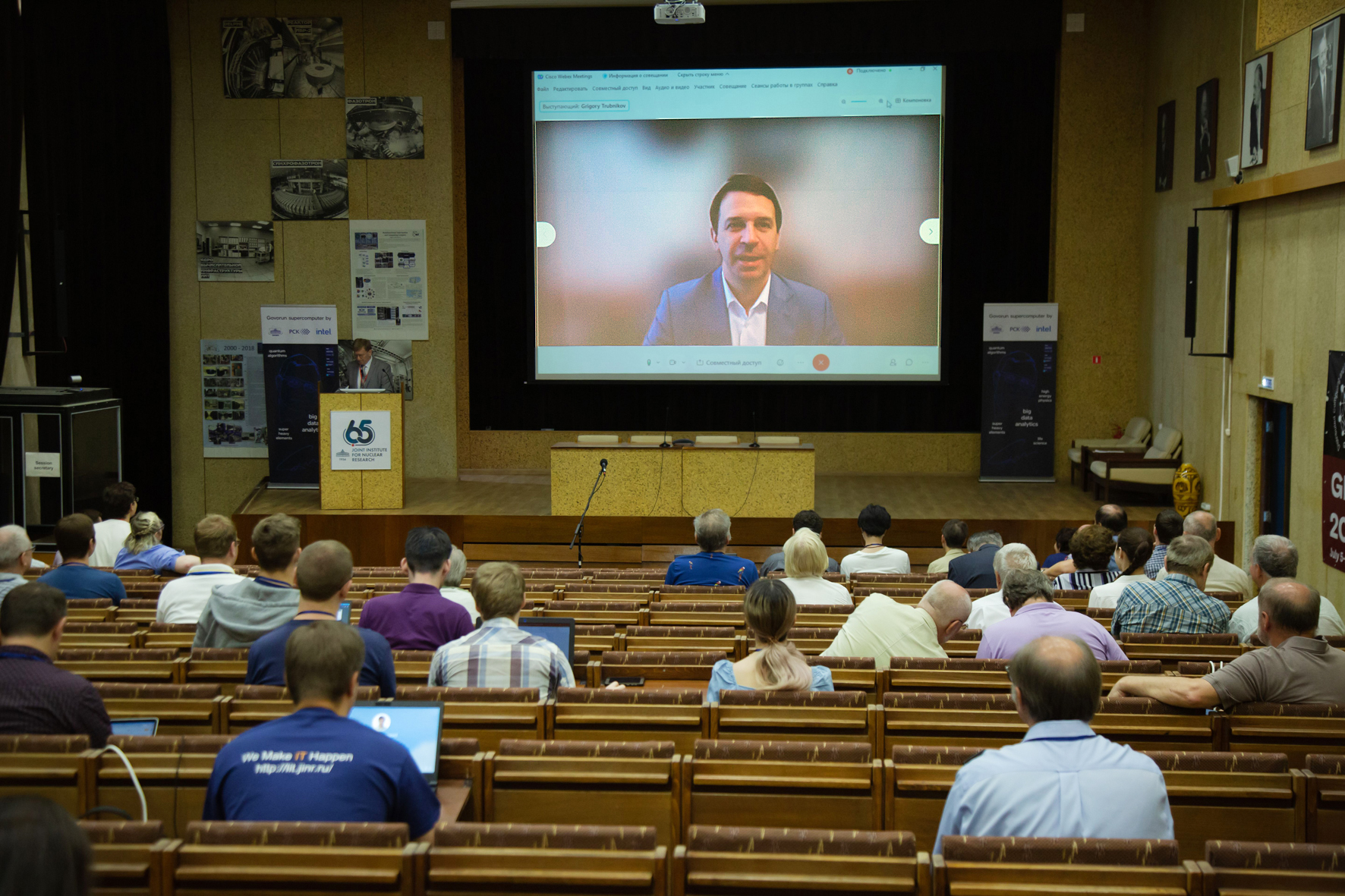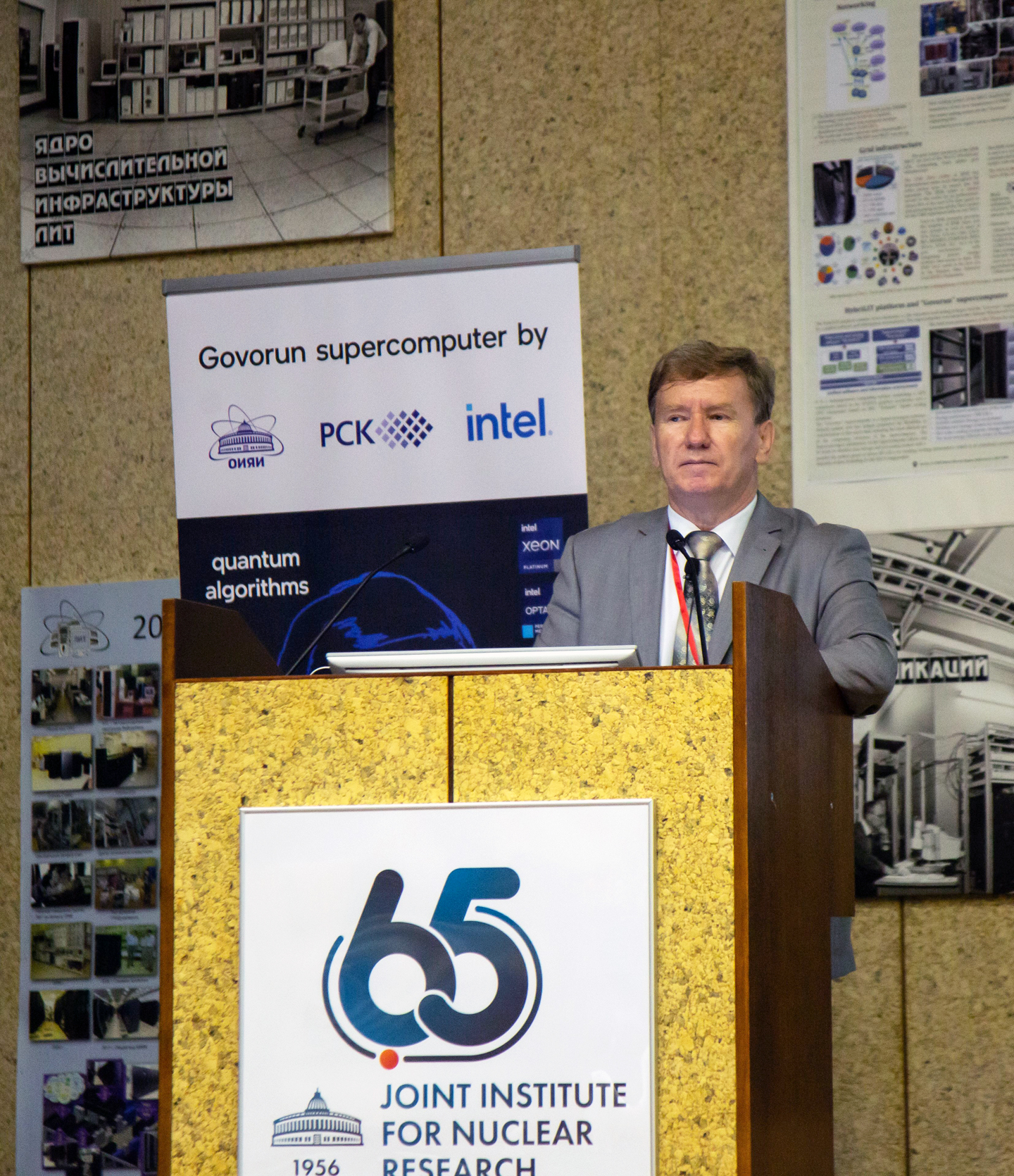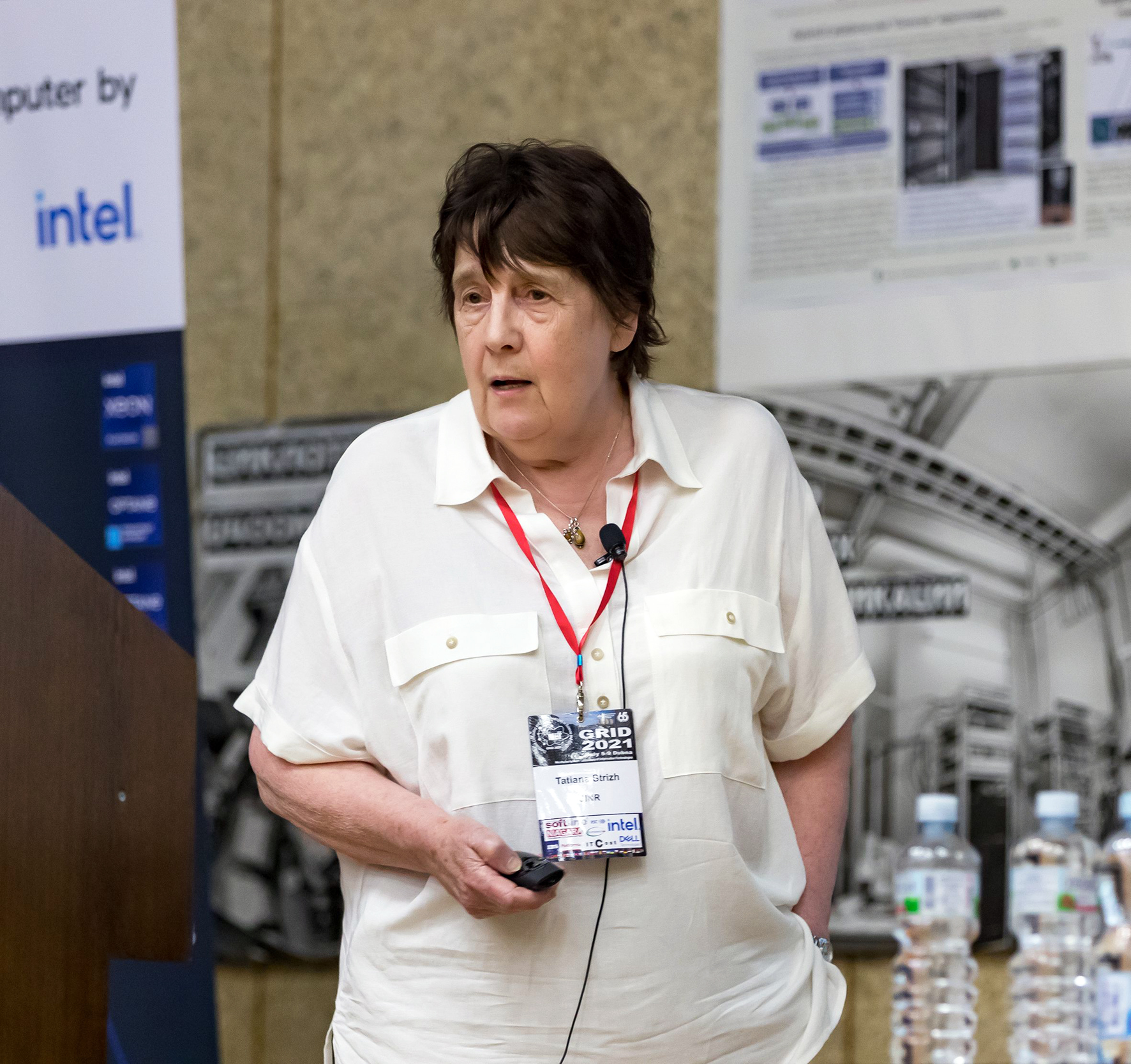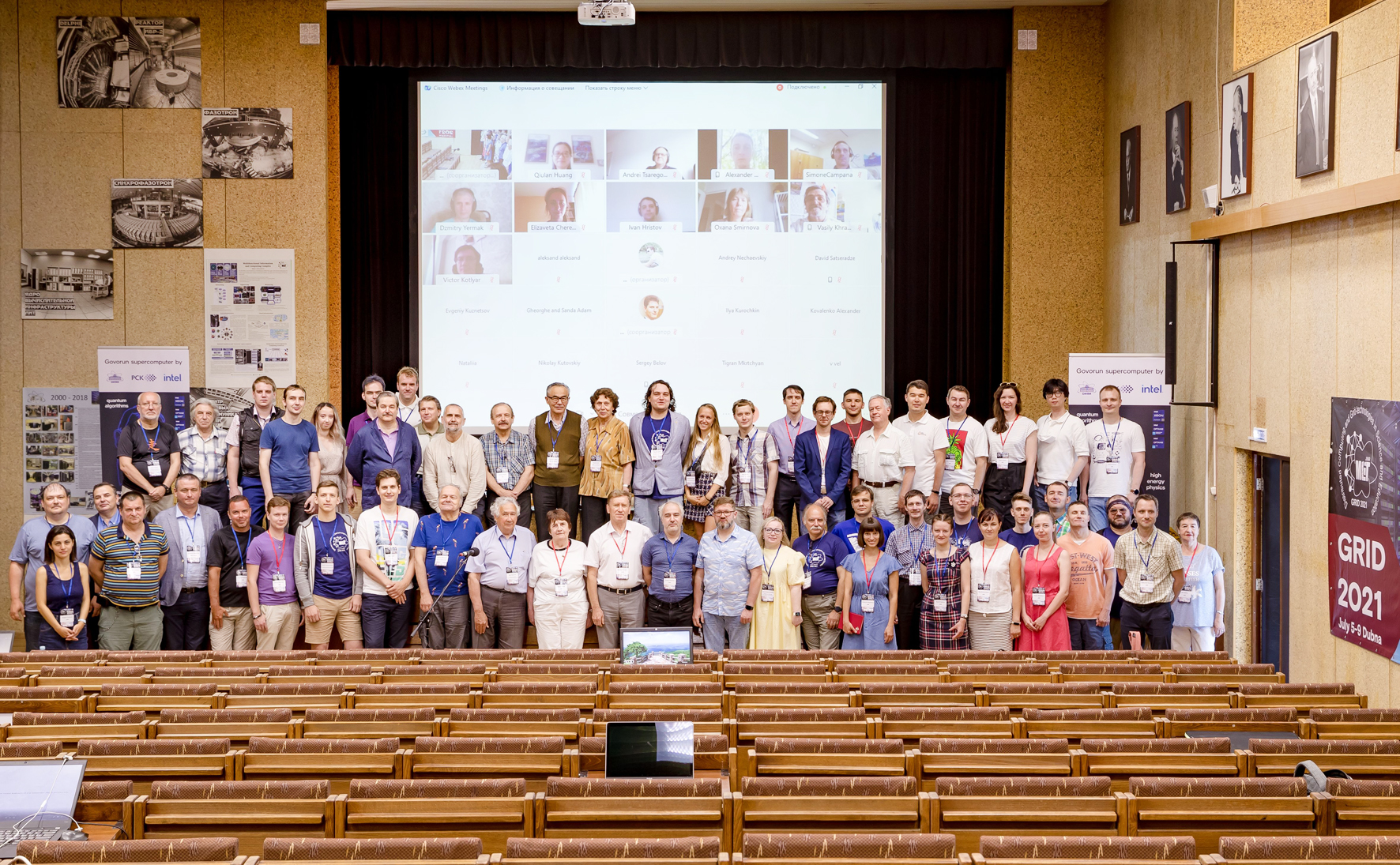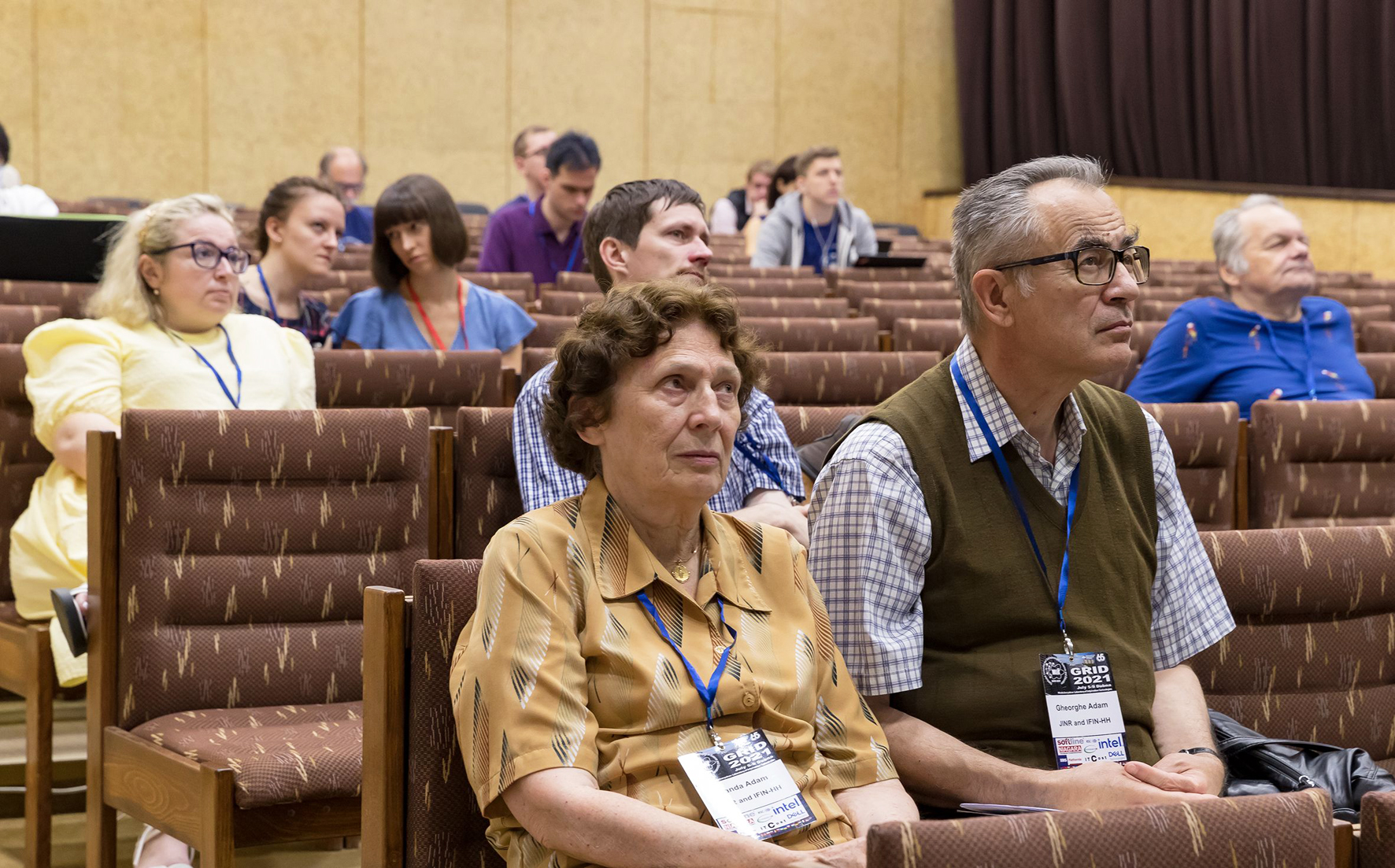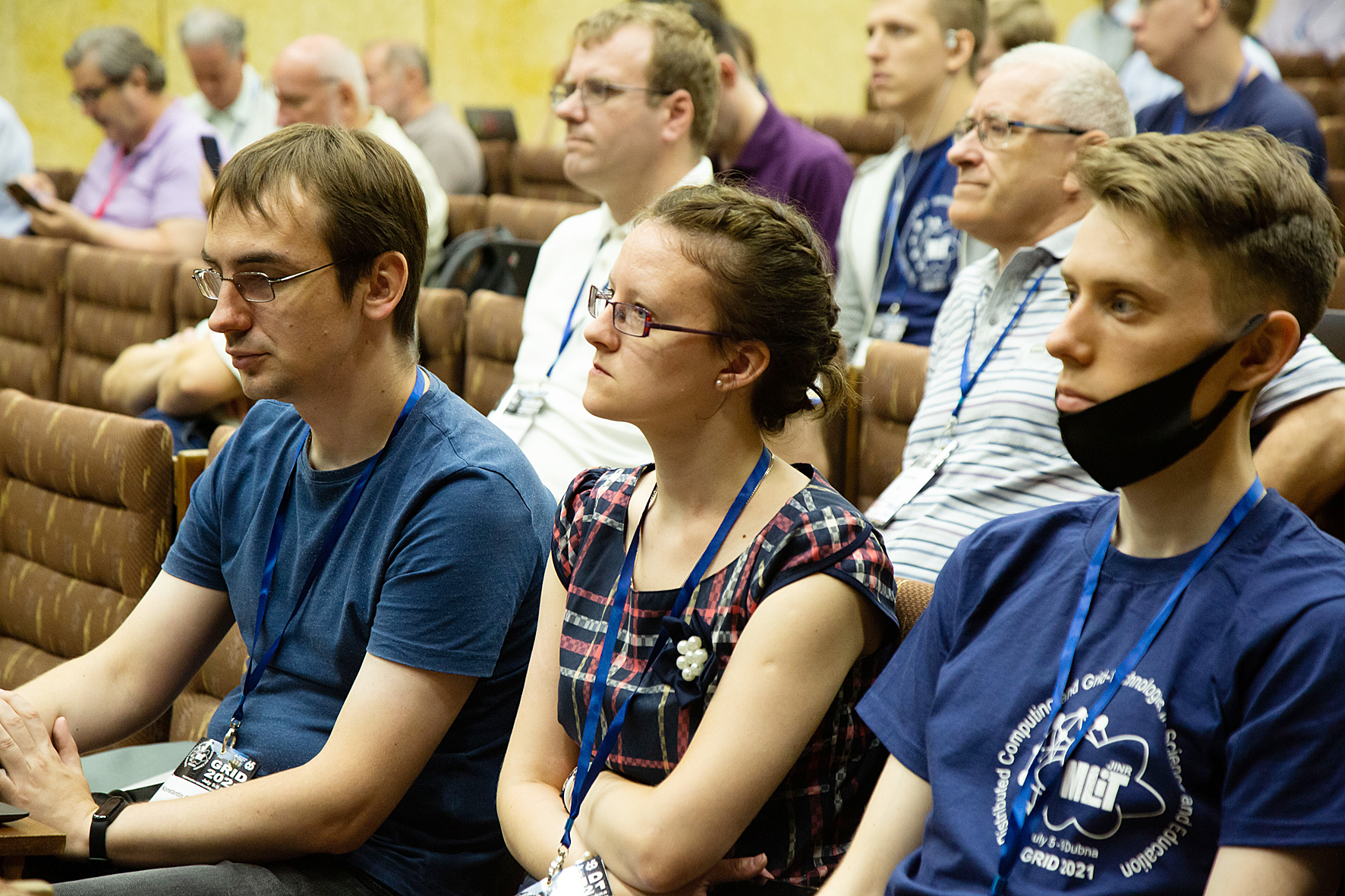GRID’2021: rich programme, record participation
News, 22 July 2021
On 5-9 July, the 9th International Conference “Distributed Computing and Grid Technologies in Science and Education” (GRID’2021) was held in the Meshcheryakov Laboratory of Information Technologies in a mixed format. The GRID conference, which takes place every two years, was dedicated to the 65th anniversary of JINR and the 55th anniversary of the foundation of the Laboratory of Computing Techniques and Automation (LCTA, now MLIT).
The conference traditionally attracted a large community of Russian and foreign experts ready to discuss emerging challenges and prospects related to the use and development of distributed grid technologies, heterogeneous and cloud computing in different fields of science, education, industry and business. This year the list of conference topics was complemented with quantum computing.
More than 270 scientists (103 – in person, over 170 – remotely) from research centres of Armenia, Belarus, Bulgaria, China, the Czech Republic, Egypt, France, Germany, Georgia, Iran, Italy, Moldova, New Zealand, Poland, Romania, Slovakia, Sweden and Switzerland took part in the conference. Russia was represented by participants from 28 universities and research centres. The conference was organized in ten sessions, where issues associated with the development of distributed computing technologies, cloud technologies, heterogeneous computing, volunteer computing and Big Data analytics, machine learning and quantum information processing were discussed.
JINR Director G.V. Trubnikov opened the conference with a report on JINR’s strategic plan for long-term development. He underlined that information technology was a dynamically developing area, and the MLIT Multifunctional Information and Computing Complex (MICC) was JINR’s basic facility. MLIT Director V.V. Korenkov
continued the strategic topic with a report on the prospects and plans for IT development at our Institute. He highlighted that MLIT would proceed to provide high-quality services and support to scientists participating in JINR’s projects both on the territory of Dubna and beyond, keeping on developing telecommunication technologies, data storages, computing systems, algorithms and software, data processing and analysis technologies, as well as information security.The talk “Prospects for the development of system programming and cybersecurity” by RAS Academician A.I. Avetisyan, a leading Russian specialist in system programming, evoked great interest among the audience.
One of the developers of the distributed computing system for the experiments at the Large Hadron Collider at CERN O. Smirnova (Lund University, Sweden) gave an overview of distributed computing in science. S. Campana (CERN) spoke about how the worldwide distributed system for processing data from the LHC experiments was changing under conditions of increasing the accelerator’s luminosity and data flow. The current state of the distributed computing monitoring and accounting infrastructure in the ATLAS experiment was presented by A. Alekseev (ISP RAS).
T. Mkrtchyan (DESY, Germany) delivered a report on the development of data storage systems based on the dCache file system. Although originally developed for high-energy physics experiments, the system is now used by a variety of scientific communities, including astrophysics, biomedicine and life sciences.
A. Tsaregorodtsev (Marseille Particle Physics Centre, France) devoted his talk to the development of the DIRAC project, which serves as the basis for building distributed computing systems. At present, the MICC computing resources and storage systems, as well as the NICA computing cluster and the cluster of the National Autonomous University of Mexico (UNAM) have been integrated using DIRAC. With the help of this distributed infrastructure, data simulation for the experiments of the NICA megascience project is performed. A distributed information and computing platform has been built on the basis of DIRAC, it integrates the cloud resources of the JINR Member States’ organizations.
A separate plenary session was dedicated to quantum computing. The recognized world expert in this field C. Calude (New Zealand) presented a report explaining the superiority of quantum computing over traditional computing methods. Leading Russian specialist in this field A.K. Fedorov (Quantum IT Group Leader, Skolkovo) spoke about quantum computing from its origins to the present day, its status in Russia and worldwide.
V.E. Velikhov (NRC “Kurchatov Institute”) delivered a plenary talk on the concept and development prospects of a new segment of the Russian consortium RDIG (Russian Data Intensive GRID) named RDIG-М, i.e. RDIG for megascience projects.
A review of the state and development prospects of the MICC at MLIT JINR was given by T.A. Strizh
(MLIT). It is noteworthy that the Tier1 grid site at MLIT is well functioning and ranks second in the world in terms of data processing for the CMS experiment; the Tier2 site is the most productive in the Russian consortium RDIG; the cloud infrastructure and the HybriLIT heterogeneous platform, including the “Govorun” supercomputer, are successfully developing.M. I. Zuev (MLIT) devoted his report to the development of heterogeneous computing at JINR on the basis of the “Govorun” supercomputer, which is a unique computing hyperconverged system with a software-defined architecture. The supercomputer is equipped with an ultrafast data processing and storage system and ranks first among Russian supercomputers in terms of the information acquisition and processing rate. “Govorun” has unique properties in flexibility of customizing for the user’s task, which makes it possible to perform resource-intensive, massively parallel calculations to solve tasks of different types in the field of theoretical research within lattice quantum chromodynamics, relativistic heavy ions, radiation biology, as well as to process and simulate data for the NICA megaproject.
At the conference there were plenary talks on the concept of computing for the SPD experiment at NICA (A.S. Zhemchugov, DLNP); on the IT development strategy at the Institute of High Energy Physics in China (Q. Huang, IHEP, China); on the status of the PIK computing center, the major task of which is to store and process data from experiments at the PIK nuclear reactor (A.K. Kiryanov, PNPI, NRC “Kurchatov Institute”).
The report of P. Lula (Cracow University of Economics, Poland) on clustering methods in the ontology-based exploratory analysis of scientific productivity and the report of V. D. Lakhno (IMPB RAS, Pushchino) on the prospects of nanobioelectronics and the creation of DNA-based electronic devices aroused interest.
Round tables organized within the conference were dedicated to the use of IT in education; to the Russian segment of WLCG (Worldwide LHC Computing Grid), i.e. RDIG; to supercomputer technologies. At one of the round tables, Intel presented its new product, the DAOS high-speed file system.
A number of plenary talks at the conference were made by representatives of the IT industry, who were sponsors of the conference. Among them were IBS Platformix, IT Cost, Niagara Computers, Dell EMC, RSC Group, Intel, Softline. Their reports provided an IT development analysis and presented trends in the development of storage systems, computer communications, novel computing architectures, as well as touched upon the issues of the design of large-scale computing centers. The sponsors were awarded diplomas.
Traditionally, during the conference, a boat trip along the Volga and Dubna rivers, followed by a barbecue in Ratmino, took place.
The conference participants were grateful for live communication. Fruitful discussions were held, and new IT projects and directions in collaboration between MLIT and organizations, universities of Russia and other JINR Member States were proposed.
During the closing ceremony of the conference, words of gratitude were expressed to the Organizing Committee for the high level of conducting such a large scientific event. A. B. Degtyarev (SPbU): “There is no science without live communication among scientists. I am thankful to the organizers for the fact that the conference took place despite the difficult epidemiological situation”.
K. Borras (DESY): “The organizers did a very good job with the mixed format of the conference, there were no problems with the connection. The conference program was rich, interesting and relevant”. G.V. Trubnikov: “An excellent event, it was particularly great to see so many vigorous young (and not only) people. The Laboratory has the highest reputation, and this is a great merit of the Laboratory’s Director Vladimir Vasilyevich Korenkov and the entire MLIT staff”.
Presentations of the presented reports and photographs are posted on the conference website. Selected proceedings of the conference will be published CEUR Workshop Proceedings.
GRID’2021 Organizing Committee,
Photos by Evgeny Goryachkin,
Elena Puzynina
On 5-9 July, the traditional conference “Distributed Computing and Grid Technologies in Science and Education GRID-2021” was held in the Meshcheryakov Laboratory of Information Technologies.The conference takes place every two years, but last year it did not happen for reasons well known to all. This year the conference, organized in a mixed format, brought together 239 participants from 19 countries. 25 plenary lectures were presented, 99 reports were delivered at parallel sessions, 3 round tables were held.
Opening the conference, MLIT Director V.V. Korenkov greeted the audience in the Conference Hall of the Laboratory and gave the floor to online participants. The first to welcome colleagues was the Dean of the Faculty of Computational Mathematics and Cybernetics at MSU, Director of the FRC “Informatics and Management” of the RAS, Academician I.A. Sokolov, who highlighted, “This is a highly interesting conference that always raises important and curious questions. The CMC Faculty and our Institute have always participated and, I hope, will participate in it now.” Director of the Institute for System Programming of the RAS, Academician A.I. Avetisyan began his speech with history by recalling the significance of Nikolai Nikolaevich Govorun’s personality for his Institute, for himself and for JINR.
The audience in the Conference Hall was greeted by I.B. Semenov (NRC “Kurchatov Institute”, ITER), I.G. Chernykh (Siberian Supercomputer Center of the Institute of Computational Mathematics and Mathematical Geophysics, SB RAS), A.B. Degtyarev (St. Petersburg State University), A.K. Kiryanov (PNPI), S.D. Valentey (Plekhanov Russian University of Economics), representatives of companies, long-term partners and reliable sponsors of the conference. GRID-2021 was opened by the report of JINR Director G.V. Trubnikov “JINR’s strategic plan for long-term development”. He began by saying that the Committee of Plenipotentiaries had approved the decision of the Scientific Council to name the Laboratory of Information Technologies after M.G. Meshcheryakov. “This conference for our Institute is part of the strategic development plan. The mission of MLIT is the development of JINR’s networks, information technologies and the computer infrastructure to enable a variety of research underway at JINR and its Member States”.
Some of the participants shared their impressions about the conference with the Institute’s media.
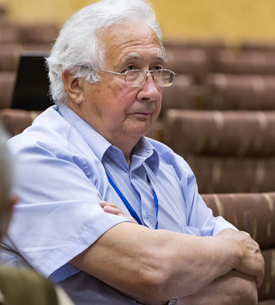 I.B. Semenov (NRC “Kurchatov Institute”): I am from a slightly different field of science, thermonuclear physics. We are currently building an international thermonuclear reactor ITER near Marseille (France). I am the Head of the Department at the ITER Project Center of Rosatom. In total, seven countries (Russia, the USA, united Europe, Korea, India, China and Japan) take part in the project. A 500 MW reactor will produce the first plasma in 2025. When the facility is running, it will produce about 2 PB of data per day. Our Project Center is actually a scientific management company. And we face the same challenges as in high-energy physics: the data must be registered, somewhere and somehow stored, distributed and processed around the world, in addition, there must be backup storage. Processing is a bit different than in high-energy physics. The temperature of the substance under study is 150 million degrees, and all physical phenomena with which we study it are not so simple. We use some of the physical phenomena in one range, some in the other, and some of these channels have a digitizing frequency of 1 GHz and higher. Thus, a million channels emerge. We started by creating a unified information space for thermonuclear facilities in Russia, which comprises leading institutes, universities and other organizations of our type. Then it will be connected to the ITER facility. In Dubna, in high-energy physics, from our point of view, this problem has been partially solved, and we came here to study.
I.B. Semenov (NRC “Kurchatov Institute”): I am from a slightly different field of science, thermonuclear physics. We are currently building an international thermonuclear reactor ITER near Marseille (France). I am the Head of the Department at the ITER Project Center of Rosatom. In total, seven countries (Russia, the USA, united Europe, Korea, India, China and Japan) take part in the project. A 500 MW reactor will produce the first plasma in 2025. When the facility is running, it will produce about 2 PB of data per day. Our Project Center is actually a scientific management company. And we face the same challenges as in high-energy physics: the data must be registered, somewhere and somehow stored, distributed and processed around the world, in addition, there must be backup storage. Processing is a bit different than in high-energy physics. The temperature of the substance under study is 150 million degrees, and all physical phenomena with which we study it are not so simple. We use some of the physical phenomena in one range, some in the other, and some of these channels have a digitizing frequency of 1 GHz and higher. Thus, a million channels emerge. We started by creating a unified information space for thermonuclear facilities in Russia, which comprises leading institutes, universities and other organizations of our type. Then it will be connected to the ITER facility. In Dubna, in high-energy physics, from our point of view, this problem has been partially solved, and we came here to study.
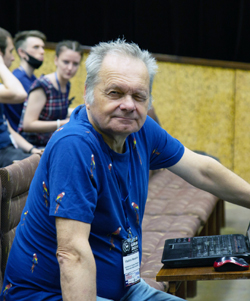 V.A. Mosolov (Institute for Nuclear Problems, Belarusian State University): I am a regular participant of this conference, although I am a physicist mainly engaged in the theory of elementary particles. However, since the task of saving the drowning people is in the hands of the drowning people themselves, we have to deal with the computer constantly. I first came to Dubna in 1977 to perform the first calculations for my thesis on CDC computers. At present, our Institute cooperates with CERN, and we interact with JINR in this area. Besides, as you know, Belarus is the JINR Member State, and we collaborate with MLIT as computing in high-energy physics entails computer power. Back in the early 2000s, we realized that we needed our own cluster, following the example of other institutes. We built the first cluster out of 15 desktops and are gradually modernizing it. Our needs are not the same as yours, however, we have the Tier3 center. It is directly connected to JINR via the cloud and works together with it. It means that it can give away part of its power or carry out calculations together.
V.A. Mosolov (Institute for Nuclear Problems, Belarusian State University): I am a regular participant of this conference, although I am a physicist mainly engaged in the theory of elementary particles. However, since the task of saving the drowning people is in the hands of the drowning people themselves, we have to deal with the computer constantly. I first came to Dubna in 1977 to perform the first calculations for my thesis on CDC computers. At present, our Institute cooperates with CERN, and we interact with JINR in this area. Besides, as you know, Belarus is the JINR Member State, and we collaborate with MLIT as computing in high-energy physics entails computer power. Back in the early 2000s, we realized that we needed our own cluster, following the example of other institutes. We built the first cluster out of 15 desktops and are gradually modernizing it. Our needs are not the same as yours, however, we have the Tier3 center. It is directly connected to JINR via the cloud and works together with it. It means that it can give away part of its power or carry out calculations together.
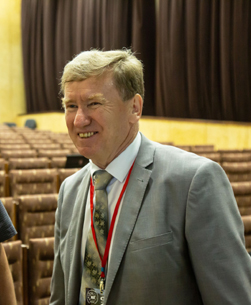 MLIT Director V.V. Korenkov: Today we are opening our traditional conference “Grid Technologies in Science and Education”, and this is already the ninth conference. We have been organizing it every two years for 17 years. Today we are holding it in a mixed format, some of the participants were able to come to Dubna, and most of them will participate remotely. The conference covers the main directions of IT development in our Institute, both in the short and long term. Therefore, leading IT experts were invited. They are involved in distributed computing, computing for megascience projects, parallel-hybrid computing, quantum computing, Big Data analytics and many other areas that are being evolved in our Institute to implement its scientific program, to modernize its basic facilities and develop international cooperation. Much attention will be paid to the development of our Multifunctional Information and Computing Complex, which is at the forefront. It has practically no analogues since it integrates grid technologies, cloud technologies, heterogeneous computing, large data storages and, most importantly, novel technologies for developing software for new platforms, including quantum computing platforms. Correspondingly, all these topics will be discussed at the conference.
MLIT Director V.V. Korenkov: Today we are opening our traditional conference “Grid Technologies in Science and Education”, and this is already the ninth conference. We have been organizing it every two years for 17 years. Today we are holding it in a mixed format, some of the participants were able to come to Dubna, and most of them will participate remotely. The conference covers the main directions of IT development in our Institute, both in the short and long term. Therefore, leading IT experts were invited. They are involved in distributed computing, computing for megascience projects, parallel-hybrid computing, quantum computing, Big Data analytics and many other areas that are being evolved in our Institute to implement its scientific program, to modernize its basic facilities and develop international cooperation. Much attention will be paid to the development of our Multifunctional Information and Computing Complex, which is at the forefront. It has practically no analogues since it integrates grid technologies, cloud technologies, heterogeneous computing, large data storages and, most importantly, novel technologies for developing software for new platforms, including quantum computing platforms. Correspondingly, all these topics will be discussed at the conference.
As for the participants, Academician A.I. Avetisyan, Director of the Institute for System Programming, a leading specialist in the field of system software, cybersecurity and the creation of protected software, is going to deliver a talk. Unfortunately, our friend V.V. Voevodin, Director of RCC MSU, one of the leading specialists in parallel computing, will not be able to participate, he planned to speak remotely, but fell ill. WLCG Project Leader Simone Campana from CERN is going to present the strategy for the development of the computer infrastructure of the LHC and other megascience projects. Tigran Mkrtchyan from DESY, head of the largest European project on data processing and storage, will give a lecture. Andrey Tsaregorodtsev from Marseille, one of the leading experts in distributed computing in Europe, and Oxana Smirnova, leading expert in computing for the LHC and specifically for the ATLAS experiment, will be also among speakers. Interesting reports on quantum computing are planned. There will be a talk by Vasily Velikhov from the Kurchatov Institute on the reorganization of our RDIG (Russian Data Intensive GRID) Federation to support Russian megaprojects. Surely, there will be a multitude of reports related to the development of our Multifunctional Complex, talks by our partners from more than 40 Russian organizations, so the program promises to be diverse and impressive.
Our conference is unusual since this year we celebrate the Institute’s anniversary and our Laboratory’s anniversary, MLIT turned 55. Last year, when the conference was supposed to take place, we celebrated the anniversaries of the birth of our founding fathers, i.e. M.G. Meshcheryakov and N.N. Govorun. We congratulate our Institute, our Laboratory on the anniversaries and remember our founding fathers who laid the foundation for what we have now. Unfortunately, many participants were unable to come, although they were going to, because the epidemic situation has worsened in the last two or three weeks. We strictly check those who arrived, all participants must be vaccinated or have a negative test, we do not want to worsen the situation. A trip along the Volga is planned; in addition to the conference participants, the JINR Directorate and directors of the Laboratories are invited. They will be able to informally discuss different directions of the development of computing and information technologies of our Institute with leading experts.
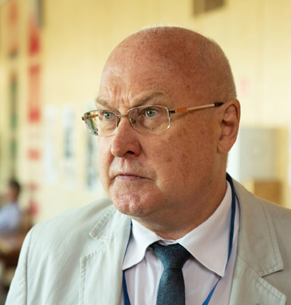 S.D. Valentey, Head of the Research Association of the Plekhanov Russian University of Economics: I will start with the fact that we met with Vladimir Vasilyevich eight years ago at a conference in the “Dubna” Special Economic Zone. I, like him, delivered a report, and even then it was clear to me that the methods of analysis that were used in economics were insufficient. The amount of information is enormous, it is multi-layered, and usual sociological surveys, usual methods allow answering some questions, but not all. Let me give you an example, this is exactly the project that was implemented in a laboratory created by V.V. Korenkov at our University. Everyone is interested in the situation on the labor market. How are studies conducted? Some polls are carried out, but this is not an analysis of the situation on the labor market, especially in the regions. For the solution, a self-learning model was developed; it enables online monitoring of the situation on the labor market through publications with “Wanted …” job posts. In this case, we replace several thousand respondents with hundreds of thousands.
S.D. Valentey, Head of the Research Association of the Plekhanov Russian University of Economics: I will start with the fact that we met with Vladimir Vasilyevich eight years ago at a conference in the “Dubna” Special Economic Zone. I, like him, delivered a report, and even then it was clear to me that the methods of analysis that were used in economics were insufficient. The amount of information is enormous, it is multi-layered, and usual sociological surveys, usual methods allow answering some questions, but not all. Let me give you an example, this is exactly the project that was implemented in a laboratory created by V.V. Korenkov at our University. Everyone is interested in the situation on the labor market. How are studies conducted? Some polls are carried out, but this is not an analysis of the situation on the labor market, especially in the regions. For the solution, a self-learning model was developed; it enables online monitoring of the situation on the labor market through publications with “Wanted …” job posts. In this case, we replace several thousand respondents with hundreds of thousands.
It turned out to be difficult to create a laboratory, for a year I tried to make this idea come to life. My colleagues, to whom I explained the necessity of creating a laboratory, answered, “Economics does not have enough data to use Big Data analytics, this is not a collider”. In fact, economics is more complicated than physics: you deal with finite quantities, and we deal with infinite ones, moreover, one must take into account the influence of psychology and more. We were the first since seven years ago no one used Big Data analytics to solve social and economic problems. At present, a data science group is formed at our University only for talented students. It is difficult to study, judge for yourself: 43 students applied for the first group, 27 of them were selected, 9 of them graduated. Now we have created a special faculty for talented students, where powerful economic and digital courses will be taught. The laboratory of Vladimir Vasilyevich and other laboratories take part in the formation of this faculty and in the elaboration of the program. My idea is this: in our universities, science comes from education, and I decided to create education from science. The base is research laboratories, they prepare special courses; surely, regular courses are taught by ordinary teachers, scientists will never take them up, and special courses must be read by the elite. It will be an elite faculty with elite specialists from JINR and abroad.
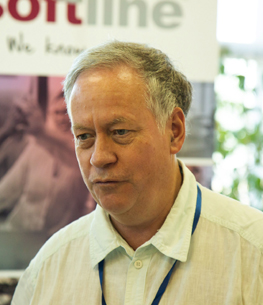 A.B. Degtyarev (St. Petersburg State University): We have been participating in this conference for a long time, I personally have been taking part since 2012. Unfortunately, last year it did not happen, so I am very grateful to Vladimir Vasilyevich Korenkov, who managed to organize an offline conference in such difficult conditions. Over the past year, we have got used to online conferences. From my viewpoint, this is a terrible substitute, which kills the very idea of the conference. In any conference, the uppermost thing is not to listen to reports and not even ask questions, but to personally communicate with those colleagues with whom you have not seen for ages, to understand what they are thinking about, what are their plans and new interesting ideas. The goal of the conference is to perceive these ideas and share your own. Publications, reports, the h-index do not play such a role as live communication, which gives us the opportunity to foster science. This year the conference “Mathematical Modeling and Computational Physics” was supposed to take place at MLIT, they go in turn, and we also participate in it.
A.B. Degtyarev (St. Petersburg State University): We have been participating in this conference for a long time, I personally have been taking part since 2012. Unfortunately, last year it did not happen, so I am very grateful to Vladimir Vasilyevich Korenkov, who managed to organize an offline conference in such difficult conditions. Over the past year, we have got used to online conferences. From my viewpoint, this is a terrible substitute, which kills the very idea of the conference. In any conference, the uppermost thing is not to listen to reports and not even ask questions, but to personally communicate with those colleagues with whom you have not seen for ages, to understand what they are thinking about, what are their plans and new interesting ideas. The goal of the conference is to perceive these ideas and share your own. Publications, reports, the h-index do not play such a role as live communication, which gives us the opportunity to foster science. This year the conference “Mathematical Modeling and Computational Physics” was supposed to take place at MLIT, they go in turn, and we also participate in it.
Essentially, these conferences stimulated our close communication, close ties, which were realized, for example, in the fact that Vladimir Vasilyevich is the chairman of the State Examination Commission for the master’s degree program at our University. Every autumn these master’s students came to JINR for practice, unfortunately, last autumn a talented group of students failed to do it. I managed to bring all our master’s students, who will graduate next year, to this conference. What matters is not that they participate in the conference, but their perception of a new scientific thought, which is in JINR, and to my mind, JINR is one of the key IT centers, not only in Russia, but worldwide. This communication resulted in the fact that my colleague, Professor A.V. Bogdanov, and I are members of the Dissertation Council at MLIT, and I am the chairman of the State Examination Commission at Dubna University. These ties lead to the fact that we move forward, we share our ideas, and they are somehow perceived here and implemented. We perceive the challenges that, for example, NICA faces in the field of computing, and we rework them, present a certain fresh perspective. This is the result of the series of conferences that have been going on for twenty years. I believe that this is the most important result of this conference.
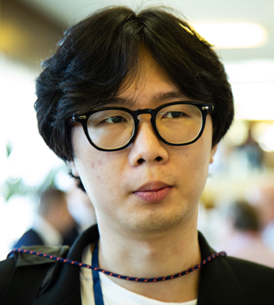 Postgraduate student of the Higher School of Economics (Moscow) Yea Rem Choi: I will be presenting my work on parallel computing. I learned about JINR only at the same time as about the conference from my scientific supervisor, he offered to participate in it. I was impressed by the number of laboratories, the variety of studies, and I thought that participation in such a conference is a good opportunity to introduce myself, to meet new people and gain some experience.
Postgraduate student of the Higher School of Economics (Moscow) Yea Rem Choi: I will be presenting my work on parallel computing. I learned about JINR only at the same time as about the conference from my scientific supervisor, he offered to participate in it. I was impressed by the number of laboratories, the variety of studies, and I thought that participation in such a conference is a good opportunity to introduce myself, to meet new people and gain some experience.
Associate Professor of the Department of Computer Modeling and Multiprocessor Systems, SPbU Ivan Gankevich: In my opinion, I take part in the conference for the third time, and the first time happened in 2012. The impressions from the conference are extremely positive, it was preceded by a whole year of the pandemic, when we could only communicate remotely, and it greatly affected the way the conference is being held. A multitude of conferences, including this one, were postponed, but, fortunately, we managed to participate.
Our major interest at the conference lies in distributed computing. There is a session devoted to it and to high-performance computing, which we also deal with. I already know many people, we managed to meet and discuss news and possible promising projects. Two of my students delivered reports here, one, however, spoke online. Our students regularly come here for practice. Every year there are master’s students who are interested in high-energy physics and some related topics, which JINR is also engaged in. We organize it in such a way that the student has a second scientific supervisor at JINR, and they work three together.
Even a year later, even in a mixed format, but the GRID-2021 conference took place. Judging by the joy with which its participants communicated, we can say that it was a success.
The results of the GRID-2021 conference will be presented in the next issue of the JINR Weekly Newspaper.
Olga Tarantina
Photos by Evgeny Goryachkin, Elena Puzynina
Video by the JINR Scientific Information Department: JINR-LIT-GRID’2021
